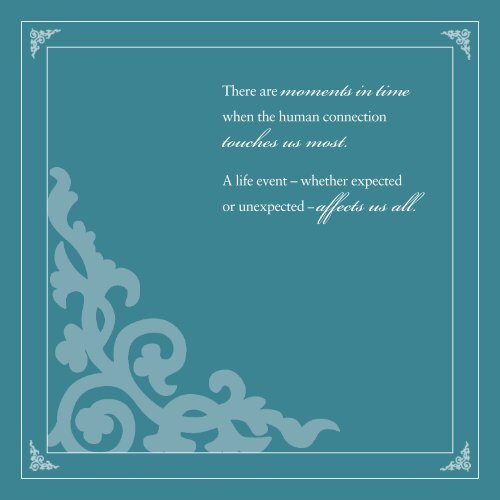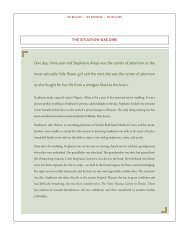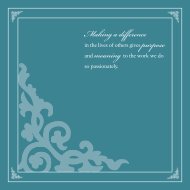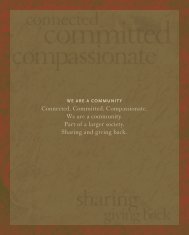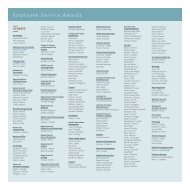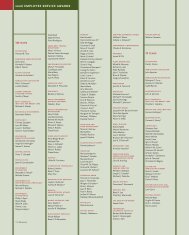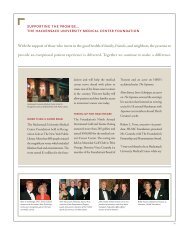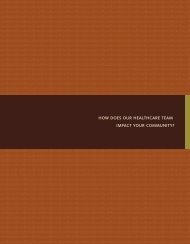out 1
out 1
out 1
Create successful ePaper yourself
Turn your PDF publications into a flip-book with our unique Google optimized e-Paper software.
There are moments in time<br />
when the human connection<br />
touches us most.<br />
A life event – whether expected<br />
or unexpected – affects us all.
acoection o carin<br />
The medical community of nearly 10,000 individuals<br />
makes a conscious decision to renew a commitment<br />
to providing exceptional patient-centered care each<br />
time they walk through the doors of Hackensack<br />
University Medical Center (HUMC). It’s a calling.<br />
It’s a personal choice. They do it for all the people<br />
who choose HUMC for their care. They do it to make<br />
a difference in the lives of others. They do it for<br />
people like Jason Kendall Ray.<br />
Jason Kendall Ray, (October 7, 1985 – March 26, 2007),<br />
has profoundly touched the hearts and the lives<br />
of all who knew and loved him as well as those who<br />
have come to know him through his legacy. His heart<br />
is reverberating nationwide and it all began with<br />
a decision.<br />
Jason Ray made many decisions in his lifetime. He<br />
chose to be involved in his church and to go on<br />
mission trips to Haiti and Honduras. He chose to be<br />
an eagle sc<strong>out</strong>, to major in business and minor in<br />
religious studies at the University of North Carolina<br />
(UNC) in Chapel Hill. At the age of 19, he chose to be<br />
an organ donor. He chose to try<strong>out</strong> for the Rameses<br />
mascot supporting the UNC’s Tar Heels basketball<br />
team, nailed it, and wore the yellow-horned mask for<br />
three seasons. He chose to be a member of the Nine<br />
PM Traffic band. And Jason chose to live his life the<br />
very best he could.<br />
A heart of gold<br />
JASON KENDALL RAY<br />
OCTOBER 7, 1985 – MARCH 26, 2007<br />
TAKE NOTICE OF THE PEOPLE AROUND YOU. A COMMON THREAD IS AT WORK EACH AND EVERY DAY.<br />
NEARLY EVERY PERSON YOU SEE, YOURSELF INCLUDED, IS FACED WITH MAKING DECISIONS – SOME<br />
CHOICES ARE CLEARLY MONUMENTAL AND UNDOUBTEDLY WILL EFFECT CHANGE AND SOME CHOICES<br />
CAN SEEM INSIGNIFICANT IN THE MOMENT BUT PROVE TO BE LIFE ALTERING, IF NOT, LIFE SAVING.<br />
March of 2007 was an exciting time for the Tar Heels.<br />
The team traveled to New Jersey to compete against<br />
S<strong>out</strong>hern California in the NCAA ® March Madness<br />
Men’s Division I Basketball Tournament scheduled<br />
for Friday, March 23, at the Meadowlands. The UNC<br />
team and its entourage stayed in a Fort Lee hotel on<br />
R<strong>out</strong>e 4. It was the day of the big game when Jason<br />
ventured <strong>out</strong>side the hotel to get a bite to eat and<br />
was involved in a pedestrian/vehicle accident that<br />
brought him to the HUMC emergency room.<br />
Sanjeev Kaul, M.D., co-chief of the Trauma/Critical<br />
Care and Injury Prevention Section of Emergency<br />
6
The proudest moment for HUMC was how we came together<br />
as a team – from the moment Jason came through the door, to<br />
facilitating the news to the family, to taking care of the family,<br />
to providing a special place for the family and friends.<br />
ABOVE: LAUREN MANSER AND CIARAN GERAGHTY WERE PART OF THE SURGICAL INTENSIVE CARE UNIT TEAM<br />
WHO HELPED THE RAY FAMILY THROUGH THE MOST DIFFICULT TIME OF THEIR LIVES.<br />
LEFT: UNIVERSITY OF NORTH CAROLINA FANS WILL ALWAYS REMEMBER THE EXCITEMENT JASON CREATED<br />
AS MASCOT FOR THE TAR HEELS. HE TOUCHED A COUNTLESS NUMBER OF PEOPLE IN LIFE AND IN DEATH.<br />
Medicine, took Jason through the doors. “Jason<br />
had injuries inside his brain and his chest; he was<br />
bleeding from his nose. He had a fractured skull and<br />
a large cut in his scalp. A lot of work was done on him<br />
in the emergency room,” said Dr. Kaul. “It was quite<br />
devastating. We knew that the odds were against him<br />
and it wasn’t going to be a good prognosis, but we<br />
didn’t know to what degree. When he arrived, he had<br />
some brain function. Brain injuries are unpredictable,<br />
but there’s always a chance there’s hope.”<br />
Jason’s parents who reside in North Carolina needed<br />
to be contacted. “I was the person that spoke to<br />
Jason’s father (Emmitt Ray). I made the call from the<br />
emergency room,” said Dr. Kaul. “It was a very<br />
difficult conversation.” Emmitt and Charlotte Ray had<br />
to get to their son as quickly as possible – a friend<br />
provided a private jet to get to New Jersey.<br />
Before the flight, Lisa Iachetti, RN, administrative<br />
director of the Emergency/Trauma Department<br />
Services, was concerned the trip would be a long<br />
one and wanted to make sure the family had the<br />
opportunity to speak with Jason, even though he<br />
would be unable to respond. “I transferred Emmitt<br />
from the landline to my spectra link phone so he could<br />
speak to Jason. I held the phone to his son’s ear,”<br />
said Lisa. “For Jason’s benefit and for the family’s<br />
benefit, it was important that he had that opportunity.<br />
There is healing involved. Dad got to tell his son<br />
he loved him.”<br />
She then gave Jason’s dad her cell phone number and<br />
asked him to call her as soon as they landed. HUMC<br />
had a security vehicle waiting for the Rays at Teterboro<br />
airport and got them to the medical center quickly.<br />
“My goal was to get Jason his parents and his parents<br />
to Jason,” said Lisa.<br />
Surreal turned into reality as the Rays faced every<br />
parent’s worst nightmare – no one could possibly<br />
prepare them for seeing their boy, so full of life when<br />
he left home, hooked up to all sorts of machines in<br />
the Surgical Intensive Care Unit (SICU) nearing the<br />
end of his life. “I remember walking through the<br />
double doors,” said his mother, Charlotte. “It was a<br />
night I will never forget.”<br />
“I met Mr. and Mrs. Ray in the SICU as soon as they<br />
arrived and we sat and talked. I was very involved<br />
with the family,” said Dr. Kaul. “It was such tragedy.<br />
The circumstances in which it could occur were terrible.<br />
Jason was from another state – a guest in New<br />
Jersey. It must have felt so awful for his parents to<br />
have this happen so far away from home. Everyone<br />
at the medical center did whatever they could to<br />
make the Rays feel at home.”<br />
As medical professionals and the Ray family focused<br />
on doing everything possible for Jason, the Tar Heels<br />
went to the Meadowlands for the game. Lisa said,<br />
“Dr. Kaul, we need to put the game on for Jason.<br />
It was a day he looked forward to. We turned his<br />
television on and placed the control next to his ear<br />
so he could hear the game.”<br />
“That’s right, we watched the game together while we<br />
were taking care of Jason,” said Dr. Kaul. “The team<br />
wasn’t doing well in the first half. I believe the team<br />
found <strong>out</strong> ab<strong>out</strong> Jason during halftime. You could see<br />
something turned around and it was an inspiring game.”<br />
March Madness took on a whole different meaning<br />
as the media reported Jason’s plight. Family, friends,<br />
7
the UNC community, and well-wishers across<br />
the nation prayed for a miracle. “Even I wanted a<br />
miracle. I believe in miracles. I have seen them<br />
happen. I know they happen,” said Dr. Kaul. “You just<br />
never know which one is going to be the miracle.”<br />
Thirty of Jason’s friends caravanned from North<br />
Carolina to be with him. “We were so concerned<br />
ab<strong>out</strong> what the hospital would do with so many<br />
people coming to see Jason,” said Charlotte. “The<br />
hospital went above and beyond the call of duty.<br />
Everyone was so wonderful to us. They arranged<br />
for a waiting area and provided pillows and toothbrushes.”<br />
Jason’s friends took turns sleeping and<br />
visiting with him around the clock.<br />
DR. KAUL EMBRACED THE OPPORTUNITY TO MEET<br />
JASON’S HEART RECIPIENT, RONALD GRIFFIN AND<br />
HIS WIFE, STEPHANIE.<br />
Pillows weren’t the only way to rest weary heads.<br />
MaryAnn Donohue, Ph.D., administrative director of<br />
Nursing Professional Services and Clinical Affairs,<br />
arranged for a grievance counselor to be available at<br />
one in the morning for all the UNC visitors who were<br />
already at the medical center and for those who<br />
arrived after the NCAA game.<br />
While UNC won the game, Jason’s prognosis<br />
diminished.<br />
On Sunday, March 25, “it became clear that Jason’s<br />
injuries were not going to be survivable,” said Dr. Kaul.<br />
“We arranged for a family meeting.” The Rays met<br />
with neurosurgeon Roy Vingan, M.D., neurologist<br />
John Noigueira, M.D., and Dr. Kaul and were given<br />
distressing news.<br />
“There was nothing we could do for Jason. For all<br />
intents and purposes, it was a devastating, fatal injury<br />
when he arrived. We focused on comforting the<br />
family members at a time that is beyond description<br />
as far as grief is concerned,” said Dr. Vingan. “We<br />
conveyed to the Rays that their son didn’t suffer any<br />
additional pain due to the comatose state he was in.<br />
We tried to take away any additional negative images<br />
that they might have regarding what their son would<br />
suffer after he was hurt. We wanted to give them<br />
peace of mind.”<br />
Jason’s decision to be an organ donor was ab<strong>out</strong> to<br />
come to fruition.<br />
Stephanie Falbo, RN, a transplant nurse with the<br />
NJ Sharing Network and coordinator for HUMC’s<br />
Organ Transplantation, approached Charlotte<br />
and Emmitt Ray to discuss Jason’s wishes and the<br />
organ donation process. It was incomprehensible –<br />
everything happening so quickly. Losing their boy<br />
and procuring his organs. “Emmitt kept saying he<br />
wanted to take Jason home,” said Stephanie.<br />
On Monday, March 26, at 8:38 a.m., Jason Kendall Ray<br />
was pronounced brain dead.<br />
Jason’s organs needed to be kept alive. “I took care of<br />
him the day he was pronounced brain dead – from<br />
7:30 a.m. until 8:30 p.m. – 13.5 hours. My role was to<br />
help the NJ Sharing Network in preparing him for his<br />
organs to be recovered,” said Lauren Manser, RN, SICU,<br />
holding back tears. “I was with him until it was time<br />
to remove his heart. It was probably the hardest day<br />
of my life here, but one of the most rewarding.”<br />
When it was time for Jason’s organs to be recovered,<br />
Emmitt told Stephanie, “This is my boy. Please take<br />
care of him.” She did just that and accompanied Jason<br />
into the operating room. “There is no greater gift than<br />
the gift that Jason gave,” she said.<br />
Jason’s organs were procured and donated to the<br />
Sharing Network of New Jersey. Jason helped more<br />
than 75 people through organ donation.<br />
Ronald Griffin of Somerset, NJ, knows Jason Kendall<br />
Ray’s heart intimately. Jason’s heart saved Ron’s life<br />
on March 26, 2007.<br />
The Griffins’ visit demonstrated the “why” everyone makes<br />
a daily commitment to providing exceptional healthcare.<br />
These are life’s defining moments.<br />
8
Congestive heart failure and cardiomyopathy were<br />
slowly taking Ron’s life. He was deteriorating, suffering<br />
strokes, he was unable to walk, talk and barely<br />
breathed on his own. He pretty much was losing all<br />
hope of living much past his 58 years. He needed<br />
more than the defibrillator or the pacemaker he<br />
received. He needed a heart. A heart that matched<br />
his 6 ft. 3 in. frame and his type O blood. Jason’s heart<br />
was Ron’s saving grace.<br />
© Rob Tringali<br />
“Organ donation works and it’s important for people<br />
to see that it works,” said Ciaran Geraghty, RN, nurse<br />
manager, SICU.<br />
Ronald Griffin and the people who know him understand<br />
just how well organ donation works. He walks<br />
into a room and it fills with his presence. He exudes<br />
“the gift of life.”<br />
More often than not, when the organs are recovered,<br />
the medical community involved in caring for the dying<br />
patient doesn’t get to meet the organ recipients. They<br />
trust that some good has come from the individual’s<br />
death whenever there is a gift of life donation.<br />
AN EXTENDED FAMILY BUILT FROM TRAGEDY. JASON KENDALL RAY’S “GIFT OF LIFE” HELPED<br />
MORE THAN 75 PEOPLE AND INCLUDED: RONALD GRIFFIN, HEART RECIPIENT; DENNIS<br />
KORZELIUS, LIVER RECIPIENT; CHARLOTTE AND EMMITT RAY, JASON’S PARENTS; DAVID<br />
IRVING, KIDNEY AND PANCREAS RECIPIENT; AND ANTWAN HUNTER, KIDNEY RECIPIENT.<br />
Ciaran and Pam Sniffen, hospital services manager<br />
of the NJ Sharing Network, felt it was time to take a<br />
look at the <strong>out</strong>come and asked Ron and his wife,<br />
Stephanie, if they would visit Hackensack University<br />
Medical Center. They said yes right away. They wanted<br />
to meet the people who took care of Jason.<br />
A day after returning from the Oprah Winfrey Show<br />
where he, the Rays, and some of Jason’s recipients<br />
told the story of the importance of organ donation,<br />
Stephanie and Ron, wearing his Oprah cap, made a<br />
visit to HUMC.<br />
As soon as the Griffins walked through the SICU<br />
double doors – the same doors Jason and his parents<br />
came through – the unit seemed changed. It was like<br />
watching the sunrise. The man who embodied<br />
a “heart of gold” both physically and spiritually<br />
connected to everyone in that room in such a<br />
spectacular way. Staff gravitated to them, embracing<br />
the Griffins – some through tight hugs, some<br />
through handshakes that seemed to go on forever<br />
and some through the warmth in their eyes as they<br />
shared knowing exchanges.<br />
“Congratulations! This is a wonderful miracle that has<br />
occurred from tragedy,” said Dr. Kaul as he shook<br />
Ron’s hand. “It’s wonderful to meet you. You truly<br />
exemplify the spirit.”<br />
Stephanie made her way over to Dr. Kaul. “Can I<br />
give you a hug from the Rays?” she asked as she<br />
embraced him.<br />
“Please tell them I said hello,” said Dr. Kaul. He can<br />
be certain his message will be relayed because the<br />
Griffins and the Rays have an incredible bond – a<br />
bond they could never have imagined but nonetheless<br />
treasure. A close relationship exists between the<br />
families. “We stayed with the Rays over Thanksgiving<br />
weekend. Emmitt told me I’m ‘welcome anytime –<br />
just as long as you bring Jason with you,’” said Ron.<br />
“Charlotte and I e-mail. She starts her e-mails with<br />
’How’s my heart today?’ How do you thank someone<br />
who has done so much?”<br />
Ron spoke of meeting Jason’s brother, Allen. “He came<br />
over to me and told me, ‘please don’t misunderstand<br />
what I’m ab<strong>out</strong> to do’ and he wrapped me in a bear<br />
hug. Then he placed his head on my chest and said,<br />
‘I need to hear Jason’s heart,’” said Ron.<br />
The Griffins’ visit demonstrated the “why” everyone<br />
makes a daily commitment to providing<br />
exceptional healthcare.<br />
9
“These are life’s defining moments. The Rays are<br />
an amazing family. Every conversation was ab<strong>out</strong><br />
what Jason would have wanted,” said Ciaran. “I have<br />
been involved with the Organ Donation and<br />
Trans planta tion Breakthrough Collaborative. Today<br />
was a great day. Once people see the benefits maybe<br />
we won’t have to ask families if they want to donate.<br />
Maybe it will become a matter of course.”<br />
Emmitt and Charlotte Ray weren’t big proponents of<br />
Jason’s decision to be an organ donor. “When Jason<br />
first told us, I told him we come into this world with<br />
little parts and we need to leave with our little parts,”<br />
said Charlotte. Today, the Rays are committed to being<br />
organ donors themselves. They understand what it<br />
means to people in need and have found some<br />
comfort in knowing others have been helped through<br />
their loss.<br />
“The proudest moment for Hackensack University<br />
Medical Center was how we came together as a team<br />
– from the moment Jason came through the door, to<br />
facilitating the news to the family, to taking care of<br />
the family, to providing a special place for the family<br />
and friends,” said Dr. Kaul. “There was a great<br />
deal – an extraordinary amount – of sensitivity and<br />
I think the Rays felt it. We treated Jason the way we<br />
would treat our own families.”<br />
Jason Kendall Ray’s “heart of gold” lives on in the<br />
hearts of all.<br />
LISA IACHETTI, RIGHT, SPOKE WITH EMMITT AND<br />
CHARLOTTE ABOUT THE TIME SHE SPENT WITH<br />
THEIR SON, JASON.<br />
Love as deep as the ocean<br />
VICTORIA HELSTOSKI GIVES HER DAUGHTER,<br />
RENATA SOME WEDDING LOVE. RENATA WEARS<br />
THE HEART NECKLACE HER MOTHER WORE AT<br />
HER WEDDING MORE THAN 50 YEARS BEFORE.<br />
LIFE IS FILLED WITH SO MANY MOMENTS,<br />
SOME WE ANTICIPATE, AND OTHERS THAT<br />
COME WHETHER WE ANTICIPATE THEM<br />
OR NOT.<br />
Our dedicated employees at Hackensack University<br />
Medical Center (HUMC), prepare for the known and<br />
unknown daily. Patients such as Victoria Helstoski,<br />
79, who did not plan on having two heart attacks,<br />
weeks and days before the wedding of her daughter,<br />
Renata Helstoski, an attorney at Beattie Padovano,<br />
LLC in Montvale, often learn what a continuum<br />
of care means for them in an environment that<br />
delivers patient- and family-centered care.<br />
“I was never sick a day in my life, and I didn’t go for<br />
help immediately when I had the first heart attack,”<br />
said Victoria. When the symptoms for the second<br />
event began, Victoria had been visiting her daughter,<br />
Andrea Cahill, and her grandchildren, Victoria,<br />
10, and Connor, 7. Andrea immediately had an<br />
ambulance bring her mom to the Emergency/Trauma<br />
Department at HUMC.<br />
“I first met cardiologist Edward Julie, M.D., and he told<br />
me he was going to stop my heart briefly and perform<br />
an emergency cardioversion,” recalled Victoria. “I<br />
had worked at the Meadowlands Racetrack for years<br />
and had seen people take risks daily, but I really fought<br />
him and the nurses on this – I was afraid. I really<br />
couldn’t believe it was possible that I was having<br />
another heart attack. I didn’t trust this procedure<br />
would save my life.”<br />
“It was our first visit to HUMC and the nurses and<br />
doctors were standing by, ready and waiting for us<br />
when we arrived – everyone, even the security guards,<br />
were wonderful to us that night and I would not<br />
dream of bringing mom anywhere else again,” said<br />
Andrea. “When I called my family to come meet us,<br />
I knew mom was really in trouble, but the team treating<br />
her was amazing, and they really won us over.”<br />
10
We recognize the fear and loss of control our patients<br />
may be experiencing during a trauma and reassure<br />
them as best we can to put their faith and trust in us.<br />
ABOVE: DONNA RAMSEY, RN, CONSULTS WITH CARDIOLOGIST EDWARD JULIE, M.D., IN THE ETD.<br />
RIGHT: OFFICER CHRIS HARLEY IS PART OF THE SECURITY TEAM ALWAYS STANDING GUARD.<br />
“Victoria’s heart muscle had sustained significant<br />
damage in the inferior wall, and I knew we had to act<br />
quickly to restore regular beating of her heart,” stated<br />
Dr. Julie. The doctor had performed this procedure<br />
many times, but never before in HUMC’s Emergency/<br />
Trauma Department. “I came away exhilarated, and<br />
called all the nurses together at 2 a.m. to compliment<br />
them on an impressive job in delivering phenomenal<br />
care in a timely and efficient manner. The night<br />
was a win-win for the patient and a win-win for the<br />
staff, and convinced me to admit patients regularly<br />
through these doors.”<br />
“Victoria’s condition was critical. Her blood pressure<br />
was extremely low and her heart rate was very fast.<br />
With her family and an anesthesiologist at the<br />
bedside, we quickly convinced her of the necessity<br />
of the cardioversion. I was both relieved and satisfied<br />
by her excellent <strong>out</strong>come,” said Jeannie Lancaster,<br />
RN, staff nurse in the Emergency/Trauma Medicine<br />
Depart ment. “When you put your training to the test,<br />
and the patient survives a medical emergency, it is<br />
the most gratifying aspect of emergency nursing. It’s<br />
a very nice feeling when a patient survives the<br />
crisis they came to us for, and that is why I enjoy<br />
nursing so much.”<br />
Monica Paganessi, D.O., anesthesiologist, acknowledges<br />
that patients in medical situations such as<br />
Victoria’s often are not in a position with many<br />
options. “We recognize the fear and loss of control<br />
our patients may be experiencing during a trauma,<br />
and reassure them as best we can to put their faith<br />
and trust in us to increase their chances of a<br />
successful <strong>out</strong>come.” With years of experience and<br />
sound medical training, she is proud that she and her<br />
colleagues truly have an opportunity to make an<br />
impact in their patients’ lives.<br />
Victoria had a defibrillator implanted in her chest<br />
prior to her discharge. “The defibrillator will treat any<br />
further heart rhythm disturbances and minimize<br />
future emergency room visits,” said Glauco<br />
Radoslovich, M.D., cardiologist, Department of<br />
Electrophysiology. “Knowing that a patient’s life can<br />
be saved by a defibrillator and the patient following<br />
a prescribed treatment plan, gives both families and<br />
physicians a sense of reassurance.”<br />
Once up on the unit, Victoria, a generous and caring<br />
woman, became depressed. She knew she wasn’t well<br />
enough to attend her daughter’s nuptials, and was<br />
angry that her body hadn’t been mindful of her<br />
calendar. Healing comes in many forms though and<br />
she never imagined her daughter and groom William<br />
Sommers, a Rutherford Police Department patrolman,<br />
would seek the approval of her cardiologists,<br />
Bruce Skolnick, M.D., and Dr. Julie, to have a private<br />
ceremony in her room on the Critical Care Unit (CCU)<br />
on 4 Pavilion East at HUMC, prior to their beach<br />
wedding in Long Beach Island (LBI). “It was the<br />
perfect solution for us,” said Renata “a chance for a<br />
private wedding ceremony with my mom first, to be<br />
followed by a reaffirmation of our vows a few days<br />
later in LBI as we had originally planned.”<br />
Here comes the bride<br />
Every bride-to-be dreams of her big day, imagining it<br />
down to all the details, surrounded by loved ones, a<br />
magnificent facility, lush gardens, acclaimed chefs,<br />
and <strong>out</strong>standing personal service. In their wildest<br />
dreams, neither Victoria nor Renata considered that<br />
facility would be HUMC. “I just knew I could not go<br />
through with my wedding in LBI with<strong>out</strong> my mother<br />
present – there was no way I could do it,” said Renata.<br />
It was already difficult enough for her because her<br />
father, the late Henry Helstoski, a six-term United<br />
States Congressman, was not going to be able to walk<br />
her down the aisle.<br />
11
RENATA HELSTOSKI BURSTS WITH ANTICIPATION AS SHE PREPARES TO GET MARRIED AT HUMC.<br />
The couple scrambled to buy a second set of<br />
wedding attire, including a second wedding dress, a<br />
second veil, a second pair of shoes for the bride, and<br />
a second set of wedding rings, and canceled their<br />
deserved another, and the smiles of relief on Renata’s best wedding gift of all, peace of<br />
honeymoon arrangements so they could be<br />
and William’s faces after their ceremony were evident.<br />
“Everything fell into place and the moment was mother’s needs. “We were very<br />
mind, while attending to his<br />
available to care for Mrs. Helstoski after their LBI<br />
wedding. Renata’s friend and co-worker, Judge Gregg<br />
true and defining,” said Renata.<br />
sad to miss the wedding, but we<br />
A. Padovano, also an attorney at Beattie Padovano,<br />
gave each other lots of hugs and<br />
LLC, joined Marianela Iribrane, director of Pastoral The moment was bittersweet for Victoria, but her<br />
I held her hand a lot,” shared<br />
Care at HUMC, in performing the ceremony at the son, Kenneth Baldanza, volunteered to spend the<br />
Kenny, who lost his father when<br />
medical center, with employees from departments couple’s planned wedding day weekend with his mom<br />
he was 14-years-old. He lives in<br />
such as Food and Nutrition Services, Photography so she would have company in the hospital while her<br />
Middletown, Delaware, but he notes, “HUMC is only<br />
and Public Relations pitching in. One promise daughter got married in LBI. He gave the couple the<br />
two hours away, and it’s nice because the CCU nurses<br />
were so <strong>out</strong>standing in their care of my mother –<br />
MAUREEN GOODMAN, RN, IS EXCITED BY VICTORIA’S PROGRESS<br />
everyone just wanted to see her get better.”<br />
DURING CARDIAC REHABILITATION.<br />
Dr. Julie continues to care for Victoria and even hopes<br />
to reverse some of the damage to her heart<br />
muscle, a feat previously thought to be impossible.<br />
“Victoria’s plans for the future include continued<br />
lifestyle changes such as smoking cessation,<br />
joining the Cardiac Rehabilitation and Prevention<br />
Center program, and taking medications. We are<br />
confident that she will feel progressively better in<br />
time and she will improve her energy level.”<br />
Victoria has recently begun participating in Cardiac<br />
Rehabilitation, and is looking forward to the opportunity<br />
to socialize, and maybe even return to work<br />
someday. “We cultivate a healing atmosphere of<br />
unconditional understanding of the mind/body<br />
connection. Teaching our patients the importance<br />
of making better choices and lifestyle changes to<br />
extend their life expectancies through mindful<br />
awareness is a prospect I love daily,” says Maureen<br />
Goodman, RN, staff nurse, Cardiac Rehabilitation<br />
and Prevention Center. Victoria is learning that<br />
long-term change is made in baby steps, and looks<br />
forward to living the benefits, with her constant<br />
companion, Missy, a two-year-old Shih Tzu,<br />
surrounded by her family and friends. “My family and<br />
I are in awe of the care I received during such a<br />
difficult and emotional, yet joyous time.”<br />
12
A New Gratitude – STAT<br />
BREATHING RIGHT WITH THE HELP OF<br />
RESPIRATORY THERAPISTS RONALD J.<br />
VANDER VLIET, CARLOS BRANCANO,<br />
AND JOHANNA ESCOBAR.<br />
ANY PARENT KNOWS WHAT IT IS LIKE TO<br />
BE AWAKENED BY A TUG ON A SLEEVE.<br />
WHEN SEVEN-YEAR-OLD REBECCA YAGER OF<br />
MON ROE, NY, WOKE HER PARENTS FOR A<br />
GLASS OF WATER, SHE HAD NO WAY OF KNOW-<br />
ING THAT SHE WAS SAVING HER FAMILY.<br />
A splice in electrical wiring would destroy their twostory<br />
home in the middle of an ice storm. Carol, 30,<br />
took Rebecca and Richard, 6, <strong>out</strong> of the house into<br />
the snow, with<strong>out</strong> even retrieving keys for her<br />
vehicle, with only a phone to call 911, while Jim, 34,<br />
went to the aid of their additional three sons, James,<br />
12, Matt, 11, and Mark, 10. The boys were lying lifeless<br />
on the floor of their bedroom, overcome from smoke<br />
inhalation and suffering from burns. An hysterical Jim<br />
got down in the snow and prayed to God for help.<br />
Left with<strong>out</strong> even the clothes on their backs, help is<br />
exactly what the Yagers got.<br />
Help from neighbor, Anthony Adamo, who subdued<br />
Jim and opened his house during the emergency,<br />
along with help from the Hudson Valley Commu nity,<br />
the Mountain Lodge Fire Company, the Mountain<br />
Lodge Park & Glenwood Hills Residents Association,<br />
St. Mary’s Parish Center in Washing tonville, Pastor<br />
R. John Winn and The Lighthouse Worship Center<br />
in Hillburn, NY, the Washingtonville Boy Sc<strong>out</strong><br />
Troop #416, the Little Ferry Fire Company, The<br />
Washing tonville School District, the Wal-Mart Super<br />
Center in Monroe, NY, and The Joseph M. Sanzari<br />
Children’s Hospital at Hackensack University Medical<br />
Center (HUMC), where the children were brought<br />
after being stabilized at Arden Hill Hospital in<br />
Goshen, NY.<br />
HUMC healthcare team members immediately<br />
understood the sense of urgency to respond to their<br />
magnified medical and emotional needs that were<br />
vast and extreme, and rose to the occasion.<br />
Commonly, cases such as these requires employees<br />
to pool resources for a family who has experienced<br />
a sudden, unexpected and random trauma, and everyone<br />
pulls together to heal them.<br />
A snowplow preceded three ambulances bringing<br />
the children in critical and serious conditions, on<br />
life-support, to the Pediatric Intensive Care Unit<br />
(PICU) of The Joseph M. Sanzari Children’s Hospital<br />
in the middle of a busy day. Stephen Percy, M.D., vice<br />
chairman of the children’s hospital, was on duty<br />
in the PICU, ready to admit the boys, along with<br />
nurses, Child Life staff, respiratory therapists and<br />
emergency equipment. “The first thing we determine<br />
is what condition the children are in and what our<br />
immediate concerns are,” said Dr. Percy. Most<br />
parents ask the same two questions – “Is my child<br />
going to be okay?” and “When can they go home?”<br />
The Yagers had to ask this question times three.<br />
“I was able to reassure the Yagers that we thought<br />
the children would be ok and they would go home<br />
as soon as they were better,” said Dr. Percy.<br />
“As a team and agents of the healing process, we<br />
make decisions inline with family needs and inline<br />
with the quality of life as they relate to the children<br />
while they are on the unit, after performing comprehensive<br />
assessments that include their physical<br />
and emotional well-being,” said Susan O. Cohen,<br />
CCLS, Pediatric Advanced Illness Care coor dinator<br />
13
of the David Center for Children’s Pain and Palliative<br />
Care. “When you face critical treatment, the<br />
preciousness of life is intensified, and the experience<br />
itself shifts one’s priorities.” She emphasizes that the<br />
family is pivotal and always at the hub. “One of the<br />
steps we took was to admit the boys in rooms in close<br />
proximity to each other so that the extended<br />
family could have better access to each other.” This<br />
action later allowed the boys to feel a connection and<br />
facilitated visits to each other once they were off<br />
life-support. The design of the private rooms allowed<br />
for the family to remain together and sleep over.<br />
Mary Shubin, RN, administrative head nurse,<br />
appreciates the concept of family-centered care, which<br />
TOP: JOHN MONDANARO DISCUSSES HOW TO HEAL<br />
THE FAMILY WITH SUSAN COHEN.<br />
BOTTOM: ONCE A TUG, NOW AN EMBRACE – JIM AND<br />
REBECCA HOLD HANDS.<br />
has long been a part of the fabric of the children’s<br />
hospital. “We all have our roadmaps and we can<br />
utilize each other as need be in order to maneuver<br />
the family through the first 24 hours, which is<br />
traditionally a turning point for them,” said Mary, who<br />
was covering the PICU on the day the Yagers arrived.<br />
“First, it was important to answer all of the family’s<br />
questions and then we enlisted Ester Reyes, LSW,<br />
social worker, to address needs such as housing and<br />
school. “Medical intervention alone does not mend<br />
the whole person,” said Alissa Sandler, LCSW, Social<br />
Work supervisor.<br />
Johanna Escobar, RRT, was the Respiratory Therapist<br />
assigned to the PICU during the boys’ admission.<br />
“I am a mother myself and I kept praying for the<br />
family. Initially, all I knew was that we had three children<br />
arriving from one family, and my heart went <strong>out</strong><br />
to them.” Johanna notified colleagues Ilene Rosenthal,<br />
CRT; Carlos Brancano, RRT; Alicia DiCamillo, RRT; and<br />
Grace Pagsambugan, RRT, of the soon-to-be arriving<br />
patients, so that each child would be able to be<br />
removed from their transport vent and switched to<br />
HUMC’s equipment with<strong>out</strong> delay. “We had to make<br />
sure the lungs were properly ventilated. It took two<br />
days before each child was able to be extubated.”<br />
Controlling the weaning process to ensure the lungs<br />
can function on their own again pain free. The<br />
extubation process, however, can be uncomfortable<br />
and scary. “The children woke up with familiar faces<br />
around them, and we reassured them that they were<br />
fine and that their lungs needed to rest,” said Johanna.<br />
“We monitor their airways and administer oxygen<br />
and facilitate getting the secretions to come up, which<br />
in the case of a fire victim, can involve a great deal of<br />
suctioning. We reassured each child on how their<br />
siblings were doing,” stated Jana Tyler, RRT, the<br />
therapist who extubated James.<br />
Ronald J. Vander Vliet, CRT, respiratory therapist,<br />
extubated Mark and was present on the unit when<br />
Matt’s tube was removed. “I get my strength from<br />
the children themselves – life throws them a curve,<br />
and they accept it at face value. Children learn to deal<br />
with what comes and work through it, and it’s very<br />
motivating.” Twenty respiratory therapists were<br />
involved during the eight days of hospitalized care<br />
of this family. “When a situation arises, no matter how<br />
large or small, we all funnel our individual emotions<br />
and utilize our various experiences to work together<br />
as seamlessly as a team, to achieve the greater good<br />
for our patients, and we feel like a family, which is<br />
why I truly enjoy working here.”<br />
What makes it possible for a nurse, even a magnet<br />
nurse, to return to the PICU day after day and deliver<br />
<strong>out</strong>standing patient care? Thia Bachemin, RN, staff<br />
nurse shares that the nurses and doctors all have a<br />
great deal of respect for each other, and are very<br />
supportive of each other. “We help each other cope,<br />
and will fill in for each other if someone needs a day<br />
off if there has been a traumatic experience or loss,<br />
because we want to keep everyone’s spirits up.”<br />
When a situation arises, no matter how large or small, we all<br />
funnel our individual emotions and utilize our various experiences<br />
to work together seamlessly as a team, to achieve the greater<br />
good for our patients. We feel like a family.<br />
14
Lindsey Olson, RN, staff nurse, feels that seeing the<br />
children improve and keeping them comfortable and<br />
holding the children’s hands is reassuring. When<br />
treating the Yager children during extubation, she<br />
would tell them how well they were doing and<br />
encouraged them not to resist the tube, explaining<br />
that perhaps tomorrow it could come <strong>out</strong>.”<br />
John Mondanaro, CCLS, supervisor of Child Life<br />
Services/Creative Arts Therapies, acted as one of<br />
Santa’s elves by quickly reaching <strong>out</strong> to assemble<br />
holiday gifts for all of the children. “This was one area<br />
that the entire Child Life team could address<br />
immediately and I was able to concretely tell Carol<br />
and Jim their children’s holiday would happen. With<br />
Christmas a short two weeks away, it was very important<br />
for them to have this stressor removed from their<br />
many concerns and to provide the family with hope<br />
and acknowledgement of the family’s value of faith.”<br />
Tara Paltridge, RN, PICU, was the nurse-in-charge<br />
and worked with the family from the moment they<br />
arrived. “It really hit home because I, too, live in<br />
Orange County.” Tara recalls the best moment of the<br />
hospitalization as the one where she was able to walk<br />
the brothers into each other’s rooms. “To see the<br />
family finally all sitting together was very special, and<br />
I think, finally, the parents were able to relax and<br />
accept that they were going to survive this.”<br />
The life-altering tragedy has left Jim a changed man.<br />
“I see everything differently now, and am filled with<br />
gratitude.” He recollects, “You know how children<br />
often interrupt you – before I was not always in the<br />
moment, and now I look them in the eye, and really<br />
listen to them. To hear what they have to say is the<br />
most important thing in the whole world,” says the<br />
father who wants to give everyone he meets hugs<br />
and kisses.<br />
Family is what matters most to the Yagers, and while<br />
their home and pets perished in the fire, Carol’s<br />
sister, Alice, and Jim’s grandmother, Helen, have also<br />
TOP LEFT: JIM PAUSES FOR PRAYER AND REFLECTION DURING A CHURCH SERVICE.<br />
TOP RIGHT: JOHANNA ESCOBAR, RRT, TRUSTS IN THE SKILLED HANDS OF HER COLLEAGUES.<br />
BOTTOM: ALIVE AND TOGETHER, THE YAGERS SHARE SOME WARM LOVE ON A COLD WINTER’S DAY.<br />
given all they can. Alice has Rebecca and Richard Intensive Care Unit (PICU) at once is scary and<br />
living with her, while the rest of the family is with shocking,” said Carol.<br />
Helen, until a new home is built.<br />
“We are so grateful to all of the nurses and doctors<br />
Days after the fire, Carol and Jim finally get treated for the wonderful care – they had James, Matt and<br />
for frostbite at Dr. Percy’s urging. At first, they had Mark well enough to join us on Christmas Eve, and<br />
refused to take care of themselves and leave their it is the best Christmas present we ever received,” an<br />
children. “To have three children in the Pediatric emotional Jim shared.<br />
15
GREAT NEWS IS LEARNING YOUR DAUGHTER IS GOING TO BE JUST FINE.<br />
Happy birthday!<br />
GERALDO RIVERA, FOX NEWS CORRESPONDENT, BROUGHT A VARIETY OF ICE CREAM<br />
AND AUNT MARY BROUGHT CARROT CAKE. IT WAS TIME TO CELEBRATE – GERALDO’S<br />
DAUGHTER, ISABELLA, WAS TURNING 15 AND BEING RELEASED FROM THE PEDIATRIC<br />
INTENSIVE CARE UNIT (PICU) AT THE JOSEPH M. SANZARI CHILDREN’S HOSPITAL ON<br />
HER BIRTHDAY.<br />
There were plenty of reasons for the Rivera family to<br />
celebrate. Just days earlier it was a frightening time<br />
for them when Isabella arrived in the Pediatric<br />
Emergency Room.<br />
“Initially, when Isabella complained of symptoms,<br />
I thought it was crankiness and dismissed it,”<br />
said Geraldo.<br />
“I started feeling sick on Halloween. I didn’t go <strong>out</strong><br />
trick-or-treating or anything,” said Isabella. A few days<br />
later, she was feeling worse. She complained her arms<br />
16
“It was the most positive experience you can possibly have.<br />
The care Isabella received was beyond a doubt as good as<br />
anywhere on the planet,” said Geraldo. “There was a remarkable<br />
level of competence and compassion.”<br />
ABOVE: DR. PERCY CONFERS WITH DR. FREDERICK ALEXANDER DURING ROUNDS IN THE<br />
PEDIATRIC INTENSIVE CARE UNIT.<br />
LEFT: DR. AVVA WORKED QUICKLY TO GET TEST RESULTS FOR ISABELLA.<br />
and legs weren’t functioning properly and she had<br />
headaches. The symptoms got progressively worse<br />
rather quickly. She couldn’t walk, she couldn’t use her<br />
hands, and her ability to speak was impaired. Isabella<br />
needed medical attention.<br />
Isabella’s sister, Simone, 13, rang her dad who was in<br />
Manhattan and told him they called 911. Geraldo<br />
rushed home in time to meet the Edgewater<br />
Ambulance Squad. The EMTs suggested they go to<br />
The Joseph M. Sanzari Children’s Hospital.<br />
Geraldo agreed. “I knew of the hospital because of<br />
Dr. Manny, the health correspondent at FOX,” said<br />
Geraldo. “I also knew of Don Imus’s involvement.”<br />
“When Isabella arrived, she couldn’t carry on a<br />
conversation. She was confused and agitated,” said<br />
Stephen Percy, M.D., vice chairman of The Joseph M.<br />
Sanzari Children’s Hospital. “Whenever there’s an<br />
acute change in mental status it becomes a medical<br />
emergency. It was important to see if there was a<br />
medical abnormality that could be reversed or if<br />
surgery would be required.”<br />
“We did testing very quickly,” said Usha Avva, M.D.,<br />
Pediatric Emergency Room. The CAT scan and spinal<br />
tap test results indicated nothing operative needed<br />
to be done.<br />
“There was an infectious process going on. We<br />
treated Isabella as though she had meningitis or<br />
encephalitis. She was given antibiotics and anti-viral<br />
medications,” said Dr. Percy. “Isabella’s headaches<br />
were due to increased pressure in her head. The<br />
spinal tap relieved the pressure which was higher<br />
than normal.”<br />
Ultimately, testing determined Isabella had a<br />
recurrence of the Epstein-Barr Virus (EBV). EBV, one<br />
of the most common human viruses, establishes a<br />
lifelong dormant infection in some of the body’s<br />
immune system cells. Sometimes reactivation occurs<br />
with or with<strong>out</strong> symptoms.<br />
“I’ve seen kids do very well and kids do very poorly.<br />
Isabella did very well,” said Carol Weber, RN,<br />
manager of PICU, who has spent 28 years caring for<br />
critically ill children. “We were all glad she was able<br />
to be released on her birthday.”<br />
“It was the most positive experience you can<br />
possibly have. The care Isabella received was beyond<br />
a doubt as good as anywhere on the planet,” said<br />
Geraldo. “There was a remarkable level of competence<br />
and compassion.”<br />
Before leaving, Isabella’s healthcare team attended<br />
her birthday party. “Geraldo was delving <strong>out</strong> cake to<br />
the staff, the patients and visitors. He even brought<br />
ice cream for the lactose intolerant,” said Carol.<br />
“Child Life made a huge card that everyone<br />
signed,” said Jennifer Brady, RN, PICU. “Isabella was<br />
very sweet.”<br />
“The entire staff, physicians, nurses, volunteers sang<br />
Happy Birthday. Her Aunt Mary made a carrot cake.<br />
I cried,” said Geraldo. “The mending – the kind of<br />
attention and care she received while recovering was<br />
incredible. I hope to always be involved there.”<br />
17
esearchers whose work has led to a dramatic increase<br />
in those surviving childhood cancer.<br />
Tomorrows Children’s relationship with HUMC has<br />
been filled with many triumphs that have had a<br />
positive impact on the community. “This anniversary<br />
is a significant event in HUMC history,” said John P.<br />
Ferguson, president and chief executive officer at the<br />
medical center. “The program has fulfilled many<br />
important needs for some of the smallest members<br />
of our community, and their loved ones. The highly<br />
skilled team, advanced services, and aggressive<br />
research activities have made it one of the largest<br />
and most comprehensive pediatric oncology<br />
programs in the nation.”<br />
Dare to dream<br />
The goal: to create the Tomorrows Children’s Institute<br />
for Cancer and Blood Disorders for world-class<br />
medicine that would comprehensively treat children<br />
with cancer, conduct cutting-edge research to find a<br />
cure, and provide critical support to help children and<br />
families manage all aspects of the disease.<br />
It was June of 1987 when the Tomorrows Children’s<br />
Institute for Cancer and Blood Disorders (TCI), first<br />
HIDING HIS LAUGHTER, JOSEPH LAZAZZERA, 5,<br />
SWEETLY TURNS HIS SMILE FROM DR. HARRIS.<br />
TWENTY-FIVE YEARS AGO A GROUP OF DEDICATED PARENTS FORMED THE TOMORROWS<br />
CHILDREN’S FUND (TCF) AND 20 YEARS AGO PARTNERED WITH HACKENSACK UNIVERSITY<br />
MEDICAL CENTER TO HELP CHILDREN WITH CANCER AND SERIOUS BLOOD DISORDERS.<br />
moved to the campus of Hackensack University<br />
Medical Center (HUMC).<br />
Today, TCI ranks among the top programs in America<br />
for childhood cancers. It is comprised of an expert<br />
team of compassionate doctors, nurses, psychologists,<br />
social workers, and child life specialists who work<br />
together to bring ab<strong>out</strong> the best possible <strong>out</strong>come<br />
for every child. Among them, leading physician<br />
Part of The Joseph M. Sanzari Children’s Hospital at<br />
HUMC, TCI was the result of a vision shared by<br />
HUMC and a small healthcare team based in New<br />
York City, that wanted to make a difference in the<br />
lives of children with cancer and blood disorders. “In<br />
1987, children in northern New Jersey often had to<br />
travel to New York City to receive the care they<br />
needed,” said Michael B. Harris, M.D., director of TCI.<br />
“The added expense and travel time often aggravated<br />
an already stressful situation for young patients and<br />
their families. Our goal was to offer New Jersey<br />
residents the high level of healthcare quality that was<br />
once only accessible to New York residents. The<br />
location of HUMC and the enthusiasm and warmth<br />
of its administration made it seem like the perfect<br />
place to start such a program. The passage of time<br />
has confirmed that the partnership we forged<br />
20 years ago was a smashing success. HUMC’s<br />
consistent support has been instrumental in the<br />
realization of what seemed an extremely ambitious<br />
dream in the mid-1980s.”<br />
Dr. Harris added that the other critical component<br />
in its success was the support of the Tomorrows<br />
Children’s Fund (TCF), a fundraising organization<br />
whose members included the Bivona, Hoffman, and<br />
Jurist families. At the time, their own children were<br />
battling cancer. TCF celebrated its 25th anniversary and<br />
has raised millions of dollars over the years to aid TCI<br />
18
Nobody expected Tomorrows Children to become what it is.<br />
The magnificence of this place is that it was made possible<br />
by the kind of people who have displayed a degree of<br />
dedication you rarely see.<br />
in providing services, to fund research, and to help ease<br />
the financial burdens of TCI patients and their families.<br />
ABOVE LEFT: LYNN HOFFMAN CELEBRATES 25 YEARS OF HEARTFELT DEDICATION TO TOMORROWS CHILDREN.<br />
ABOVE RIGHT: CARLIE CORD, AN ORIGINAL TCI NURSE, IS PART OF AN EXPERT TEAM OF HEALTHCARE PROFESSIONALS.<br />
“Nobody expected Tomorrows Children to become<br />
what it is,” Mr. Jurist said. “The magnificence of this<br />
place is that it was made possible by the kind of<br />
people who have displayed a degree of dedication<br />
you rarely see. It’s been a great pleasure to be a part<br />
of it.<br />
“We have also been fortunate to have wonderful<br />
people get involved in our organization,” Mr. Jurist<br />
continued, “people like Don Imus, George Martin,<br />
Mark Messier, and Karl Nelson, people who have<br />
given so much.”<br />
“TCF has sort of taken on a life of its own,” Mr. Bivona<br />
said. “When we started <strong>out</strong>, we just wanted to do a<br />
few things to make our kids as comfortable as<br />
possible. We never dreamed we’d get a building.”<br />
Lynn Hoffman, now the executive director of TCF,<br />
remembers thinking how wonderful it would be if<br />
she could just get a cup of coffee while she was with<br />
her daughter at the hospital.<br />
“All we knew initially was that we wanted to make a<br />
difference in the children’s lives,” said Ms. Hoffman.<br />
“I am very grateful to acknowledge everyone who<br />
has put us on the map, and thank all of our staff,<br />
because we still have a dream.”<br />
One of the major accomplishments was the<br />
ability to offer a wide range of services to everyone<br />
affected by childhood cancer. “TCI brings new<br />
meaning to comprehensive cancer care,” said Jeffrey<br />
Boscamp, M.D., chairman and physician-in-chief<br />
of The Joseph M. Sanzari Children’s Hospital. “It<br />
recognizes that the fight against cancer must be<br />
fought on a psychological as well as a clinical front.<br />
In addition to providing state-of-the-art medical<br />
care, Tomorrows Children offers extensive psychological<br />
services, including supportive programs<br />
for patients, their parents, siblings, friends, grandparents,<br />
and others.”<br />
Through the years, physicians and nurses have<br />
devoted considerable time and resources to the<br />
advancement of cancer care through research, even<br />
taking on governing roles with the Children’s<br />
Oncology Group (COG), an international organization<br />
whose mission is to cure and prevent childhood<br />
and adolescent cancer through scientific discovery<br />
and compassionate care. As a result, patients<br />
have the option of participating in the scores of<br />
innovative research trials offered in conjunction<br />
with COG.<br />
Now that TCI and TCF officials have succeeded in<br />
creating one of the nation’s premier pediatric centers,<br />
the new frontier has become research. “In the past<br />
25 years, we have come so far, the next logical step<br />
is to work on finding a cure. If you don’t dare to dream<br />
it, you’re never going to see it happen,” Mr. Jurist said.<br />
While the Bivonas, Hoffmans, Jurists, and so many<br />
others do the dreaming and help provide funds,<br />
the top-notch medical staff led by Dr. Harris makes<br />
it happen.<br />
As long as there are children with cancer, there will<br />
be TCF and TCI to bring ab<strong>out</strong> a cure for every child<br />
and to help survivors manage treatment effects.<br />
Together they man the frontlines aiding patients who<br />
battle cancer every day.<br />
TOP: JUDY SOLOMON, A SOCIAL WORKER; HOPE CASTORIA,<br />
A NURSE AT CURE AND BEYOND; AND DR. HARRIS VISIT WITH<br />
JOSEPH DURING HIS TREATMENT.<br />
BOTTOM LEFT: EILEEN JURIST IS LIVING PROOF OF THE<br />
DREAM OF CHILDHOOD CANCER SURVIVORSHIP BECOMING<br />
A REALITY. HERE EILEEN WHISPERS SWEET NOTHINGS TO HER<br />
10-MONTH-OLD SON, LIAM.<br />
BOTTOM RIGHT: DR. CINDY STEELE, ASSOCIATE DIRECTOR,<br />
TCI AND DR. HARRIS CONFER IN THE REUTEN CLINIC.<br />
19
“Working with the wonderful people of Tomorrows Children is so gratifying. I am inspired by their endless compassion,”<br />
said Anne Kreminski, operations manager of TCI. “Their dedication to providing <strong>out</strong>standing care to children afflicted with<br />
cancer and blood disorders is one of a kind.” • “I love working in TCI. Here, I have the opportunity to work with a highly<br />
motivated multidisciplinary team of people who have the biggest hearts. You can feel the energy in the air and it makes<br />
you want to be a part of it,” said Laura VanDePutte, RN, nurse manager of the Reuten Clinic. • “There is a purpose to<br />
each day and I feel that I am working toward an important goal, the care of our patients,” said Ellen Goldring, chief of<br />
Child Life and Creative Arts Therapies. “There is a deep feeling that we are all working for the same cause.” • “We are<br />
so proud of the relationships we have developed with our patients and their families through<strong>out</strong> the years; they have<br />
helped us refine the art of nursing,” said Diane Ohme, RN, nurse manager, inpatient unit of Pediatric Hematology/Oncology.<br />
“It is our honor and privilege to be a part of their lives and to provide them with exceptional care.”<br />
20


